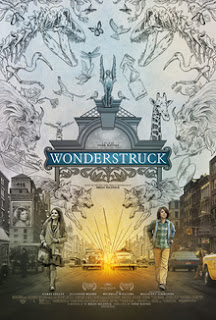Wonderstruck
I was a bit wonderstruck watching Wonderstruck, Todd Haynes' latest film. One will immediately make comparisons to Hugo, which is only right, since they are both based on books by Brian Selznick, who writes the screenplay here. They are both films that approach magic realism without quite getting there, and romanticize places--in Hugo it is the Paris train station, in Wonderstruck it is The American Museum of Natural History, or more precisely, museums in general.
Wonderstruck tells two parallel stories about deaf children on the loose in New York City. The earlier is about Rose (Millicent Simmonds), who lives in Hoboken in 1927. She idolizes a movie star, Lillian Mayhew (Julianne Moore) and sees that she is going to be appearing live so she hops on the ferry for her first visit across the Hudson. She finds Moore, and a bit of a twist is revealed, but then leaves and looks for her brother Walter, who works in the Natural History Museum and has authored a book, called Wonderstruck, about the history of museums.
The later story is of Ben (Oakes Fegley) in 1977, who has been orphaned by his mother's death in a car accident (she is played briefly and luminously by Michelle Williams). She has never told him about his father, which seems cruel. Nevertheless, after he loses his hearing while being on the phone in an electric storm (the rumors are true!) runs away to New York based on a clue that he finds tucked inside a book--you guessed it, the book written by Walter.
The momentum of the story is finding out how these stories will connect, which is the weakest part of the film--the story is predictable and very thin. Also, having two deaf characters requires a lot of writing, which I suppose works fine in a book but is awkward in a film.
On the plus side, and it's a big plus, is the look of the picture. The 1927 portion is especially fantastic, with costumes by Sandy Powell and stunning black and white photography by Ed Lachman. Watching Simmonds explore the city creates an almost vicarious feel (Simmonds is actually deaf, but has a face that would launch a thousand ships). Often scenes of her looking at something in the museum are cut with Fegley looking at the same thing, still there after fifty years. His segment, in which New York was in not such a great shape (although I still think the Port Authority looks like that now) are in a kind of uncompromising color, but he finds a friend whose father works for the museum, and they hide out there in the night (sadly, nothing comes to life).
The ending, which winds up at the site of the World's Fair in Queens, isn't as poignant as it thinks it is (it involves a true life event that I won't spoil here, but if you know your New York history you'll figure it out). When Moore appears as another character in Ben's segment, it doesn't take a genius to put two and two together.
See Wonderstruck for the visuals, or for the nostalgia for old New York. Try to overlook the simplicity of the story.
Wonderstruck tells two parallel stories about deaf children on the loose in New York City. The earlier is about Rose (Millicent Simmonds), who lives in Hoboken in 1927. She idolizes a movie star, Lillian Mayhew (Julianne Moore) and sees that she is going to be appearing live so she hops on the ferry for her first visit across the Hudson. She finds Moore, and a bit of a twist is revealed, but then leaves and looks for her brother Walter, who works in the Natural History Museum and has authored a book, called Wonderstruck, about the history of museums.
The later story is of Ben (Oakes Fegley) in 1977, who has been orphaned by his mother's death in a car accident (she is played briefly and luminously by Michelle Williams). She has never told him about his father, which seems cruel. Nevertheless, after he loses his hearing while being on the phone in an electric storm (the rumors are true!) runs away to New York based on a clue that he finds tucked inside a book--you guessed it, the book written by Walter.
The momentum of the story is finding out how these stories will connect, which is the weakest part of the film--the story is predictable and very thin. Also, having two deaf characters requires a lot of writing, which I suppose works fine in a book but is awkward in a film.
On the plus side, and it's a big plus, is the look of the picture. The 1927 portion is especially fantastic, with costumes by Sandy Powell and stunning black and white photography by Ed Lachman. Watching Simmonds explore the city creates an almost vicarious feel (Simmonds is actually deaf, but has a face that would launch a thousand ships). Often scenes of her looking at something in the museum are cut with Fegley looking at the same thing, still there after fifty years. His segment, in which New York was in not such a great shape (although I still think the Port Authority looks like that now) are in a kind of uncompromising color, but he finds a friend whose father works for the museum, and they hide out there in the night (sadly, nothing comes to life).
The ending, which winds up at the site of the World's Fair in Queens, isn't as poignant as it thinks it is (it involves a true life event that I won't spoil here, but if you know your New York history you'll figure it out). When Moore appears as another character in Ben's segment, it doesn't take a genius to put two and two together.
See Wonderstruck for the visuals, or for the nostalgia for old New York. Try to overlook the simplicity of the story.



Comments
Post a Comment